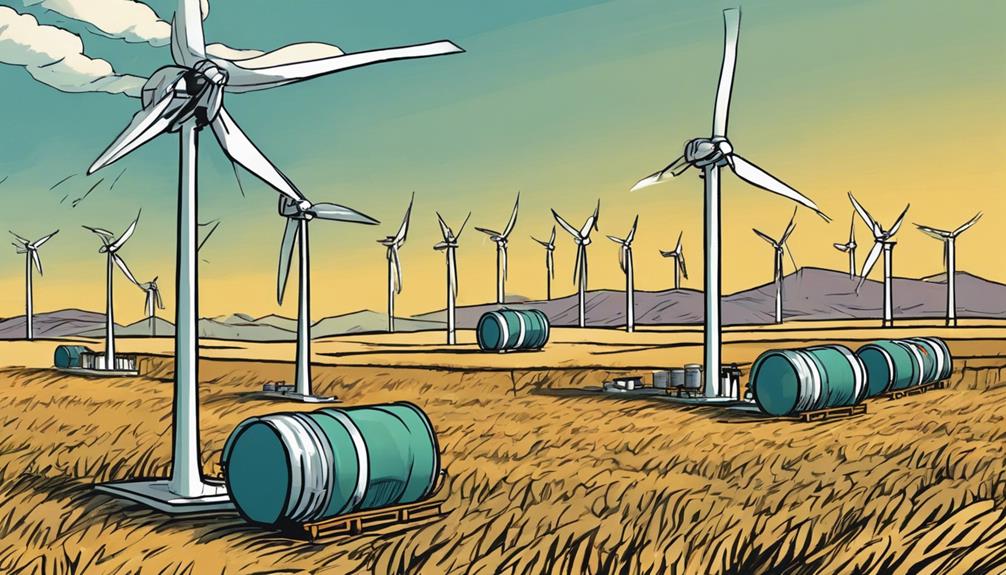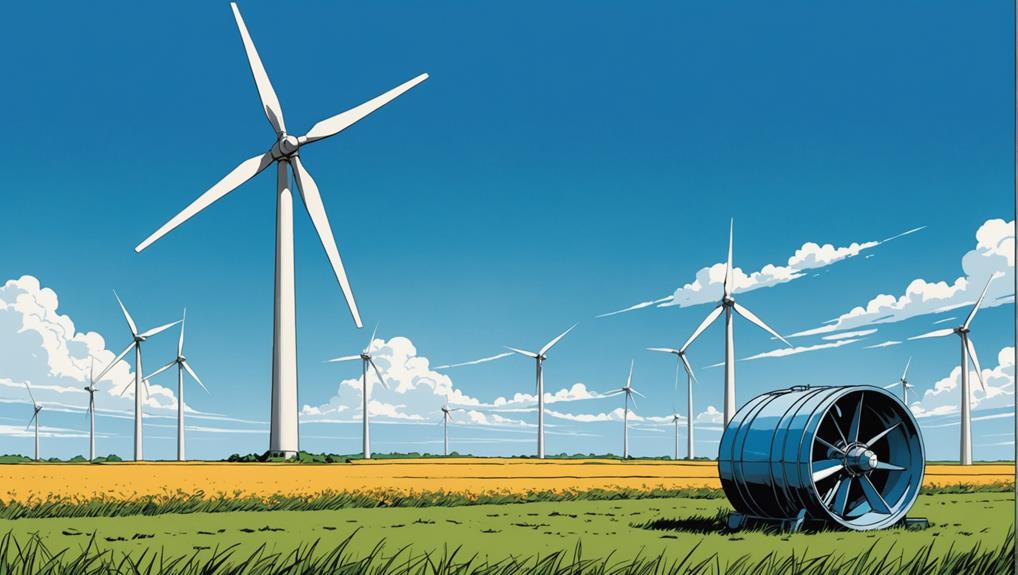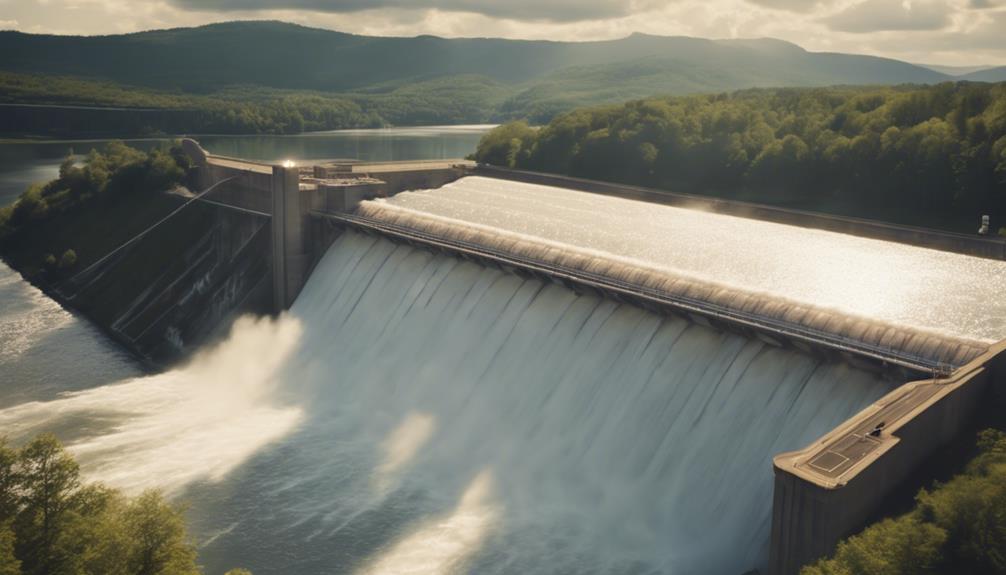Wind turbines need oil for gearboxes and transformers. Each turbine typically uses 800 gallons of gear oil and 1200 gallons of transformer oil yearly. On average, they require 80 gallons of oil annually. Wind farms with many turbines notably increase oil demands. It's enlightening to discover more about the impact of proper lubricant selection and regular maintenance on wind turbine productivity and environmental sustainability.
Key Takeaways
- Gear oil: around 800 gallons per turbine for gearboxes.
- Transformer oil: approximately 1200 gallons per turbine for transformers.
- Annual oil consumption: averages 80 gallons per turbine.
- Synthetic oils are preferred for wind turbine applications.
- Proper maintenance crucial for productivity and environmental sustainability.
Oil Consumption in Wind Turbines
Wind turbines require a significant amount of oil for proper operation, with an average turbine consuming up to 2000 gallons of oil. This oil consumption is divided between the gear oil, essential for the gearbox, and the transformer oil, essential for the transformer linked to the turbine.
The gearbox of a wind turbine relies on approximately 800 gallons of gear oil, while the transformer may utilize around 1200 gallons of oil. Proper lubrication plays a crucial role in ensuring the efficiency and longevity of wind turbines. Adequate oil levels are necessary to maintain the smooth operation of components like the gearbox and minimize wear.
Without sufficient oil, the turbine's performance could be compromised, leading to potential breakdowns and reduced efficiency. To guarantee optimal functioning and durability, it's essential to monitor and replenish the oil levels in wind turbines regularly.
Lubricant Selection for Wind Turbines

Selecting the appropriate lubricants is important for ensuring the efficient operation and longevity of key components in wind turbines. Proper lubricant selection is essential for the gearbox, pitch gear, open gear, and yaw gear to function smoothly. Synthetic oils are preferred in wind turbine applications due to their stability, efficiency at lower temperatures, and viscosity index. These lubricants play a significant role in reducing friction, preventing premature wear, and maximizing the performance of wind turbine components. By choosing the right lubricant and following proper maintenance practices, you can extend the lifespan of wind turbines and optimize their energy production capabilities.
| Component | Lubricant Type | Significance |
|---|---|---|
| Gearbox | Synthetic Oil | Ensures smooth gear operation |
| Pitch Gear | Synthetic Oil | Maintains pitch system efficiency |
| Open Gear | Synthetic Oil | Prevents wear and tear |
| Yaw Gear | Synthetic Oil | Facilitates yaw control |
| Friction | Reduced | Enhances overall performance |
Maintenance Practices for Wind Turbines

Proper upkeep practices for wind turbines necessitate consistent oil refilling to uphold peak operational efficiency. Wind turbines typically require an average of 80 gallons of oil per year to operate efficiently. Oil changes and lubrication maintenance are essential to prevent equipment failure and reduce maintenance costs.
Following manufacturer recommendations for oil usage and maintenance schedules is vital for wind turbine longevity. Regular oil checks and replacements help sustain wind turbine productivity and performance levels. Neglecting these maintenance practices can lead to decreased performance and potential breakdowns, resulting in higher repair expenses.
Impact of Oil Usage on the Environment

You must consider the environmental consequences of oil usage in wind turbines, especially regarding recyclability and disposal challenges.
The sustainability of turbine components like blades is a pressing concern, demanding innovative solutions for a greener future.
The impact of oil consumption on the environment necessitates exploring more eco-friendly practices in wind turbine maintenance.
Environmental Oil Impact
Wind turbines' significant oil requirements pose environmental challenges due to their impact on the environment. To understand the environmental oil impact of wind turbines, consider the following:
- Oil Usage: Wind turbines require up to 800 gallons of gear oil and 1200 gallons of transformer oil, contributing to environmental concerns.
- Blade Disposal: The non-recyclable nature of wind turbine blades leads to burial, posing challenges for sustainability.
- Diesel Engines: Windmills rely on diesel engines for initiation and electric heating in gearboxes, impacting oil usage.
- Proper Maintenance: Proper oil disposal and management are essential to minimize the environmental impact of wind turbine oil usage.
Balancing the benefits of wind energy with the environmental implications of oil usage is vital for sustainable energy practices. By ensuring proper maintenance, disposal, and monitoring of oil usage in wind turbines, we can work towards a more environmentally friendly approach to harnessing wind energy.
Sustainability Concerns
The impact of oil usage on the environment in wind turbine operations raises considerable sustainability concerns. Hydraulic oil in wind turbines boasts a long lifespan and typically doesn't require frequent replacement, promoting sustainability.
Filtering systems within wind turbines play a vital role in maintaining hydraulic oil in like-new condition, thereby reducing the environmental impact. Wind turbine operators are key players in ensuring the sustainability of hydraulic oil usage and maintenance practices.
It's crucial to prioritize responsible management of hydraulic oil in turbines to achieve greener wind power solutions. Political decisions concerning wind farm development can markedly influence the sustainability of hydraulic oil usage in the industry.
Scaling Oil Needs for Wind Energy

You need to think about how the estimated oil consumption for wind turbines can impact sustainability efforts.
Finding sustainable lubrication solutions is essential to manage the oil needs of a large-scale wind energy operation efficiently.
Balancing the necessity of oil for wind turbines with environmental concerns is vital to ensuring sustainable energy production.
Oil Consumption Estimates
Amidst the push for greater adoption of wind energy, considerations about the substantial oil consumption required to maintain wind turbines have become increasingly prominent.
Here are some key facts to help you understand the oil consumption estimates for wind turbines:
- An average wind turbine requires approximately 80 gallons of oil annually for proper lubrication.
- Scaling up, a wind farm with 150 turbines would need around 12,000 gallons of oil each year to operate efficiently.
- To power a city like New York with wind energy, an estimated 3,800 turbines would consume about 304,000 gallons of refined oil.
- The oil consumption for wind turbines raises questions about sustainability and the environmental impact of oil usage in renewable energy production.
Finding alternative lubrication methods for wind turbines is vital for addressing the significant oil resources needed for large-scale wind energy production.
This shift towards sustainable practices in the maintenance of wind turbines is essential for advancing the environmental benefits of wind energy.
Sustainable Lubrication Solutions
Considering the large oil consumption required to maintain wind turbines, exploring sustainable lubrication solutions becomes imperative in scaling oil needs for wind energy production.
The current oil usage in wind turbines raises sustainability concerns and highlights the environmental impact of traditional lubricants. To align with renewable energy goals and minimize the environmental footprint, innovative approaches to wind turbine lubrication are essential.
Implementing sustainable lubrication solutions not only reduces the dependency on fossil fuels but also contributes to a more eco-friendly operation of wind farms. By shifting towards environmentally friendly lubricants made from bio-based or recycled materials, the oil needs of wind turbines can be notably reduced.
These sustainable lubrication solutions offer a promising pathway towards achieving a more sustainable future for wind energy production, where the focus isn't only on generating clean power but also on ensuring the entire process aligns with conservation efforts.
Oil Usage in Windmill Components

Windmills depend heavily on oil for lubrication in their components, with a single turbine consuming up to 800 gallons of gear oil. This oil is essential for the smooth operation of various parts within the wind turbine system.
Here are some key points to ponder regarding the oil usage in windmill components:
- Wind turbines also rely on approximately 1200 gallons of oil for the proper functioning of the connected transformer, highlighting the significant oil consumption in wind energy systems.
- Diesel engines play an important role in initiating the movement of windmills, further contributing to their overall oil consumption for operations.
- Electric heating systems are utilized to regulate and maintain the gearbox temperature in wind turbines, ensuring the best performance and longevity of the components.
- Disposal of non-recyclable windmill blades is an essential aspect to take into account, as they often need to be appropriately disposed of, such as through burial methods.
Recycling and Repurposing Wind Turbine Oils

With the growing concern over the recyclability of oils used in wind turbines, exploring sustainable disposal solutions is becoming increasingly crucial.
Repurposing used turbine oils for other applications could greatly reduce environmental impact and promote resource efficiency.
Comparing oil consumption in wind turbines to that of large generators can provide insights into sustainability and recycling potential.
Advancements in material science and efficiency play a crucial role in addressing the environmental implications of wind turbine oil usage.
Finding alternative lubrication methods for wind turbines is essential for achieving long-term energy sustainability and reducing oil waste.
By implementing innovative recycling and repurposing strategies for wind turbine oils, we can minimize the environmental footprint of these renewable energy systems while maximizing resource efficiency.
Embracing sustainable practices in handling oil waste from wind turbines not only benefits the environment but also contributes to a more sustainable future for wind energy.
Future of Lubrication in Wind Energy

How will advancements in lubrication technology shape the future of wind energy sustainability?
The future of lubrication in wind energy is evolving rapidly to meet the demands of modern wind turbines. Here are some key developments to look out for:
- Bio-based Lubricants:
The shift towards environmentally friendly solutions is driving the development of bio-based lubricants that offer enhanced performance and reduced environmental impact.
- Nanotechnology-enhanced Lubricants:
Nanoparticles are being incorporated into lubricants to improve their lubricating properties and increase efficiency in wind turbine applications.
- Predictive Maintenance Strategies:
Real-time condition monitoring systems are being implemented to predict maintenance needs accurately, reducing downtime and increasing turbine reliability.
- Collaboration in Wind Energy:
Collaboration among stakeholders is fostering innovation in lubrication technology, ensuring that wind turbines operate effectively in harsh operating conditions.
These advancements, along with the use of additive technology such as anti-wear and extreme pressure additives, are paving the way for more efficient and sustainable wind energy production.
Frequently Asked Questions
How Much Oil Does It Take to Operate a Wind Turbine?
To operate a wind turbine, you need a specific amount of oil for best performance. It's important to take into account the oil requirements for each turbine and factor in the total consumption for large-scale wind farms.
Do Wind Turbines Leak a Lot of Oil?
Wind turbines generally don't leak a lot of oil. Proper maintenance and monitoring help minimize leaks caused by seal failures or gearbox issues. Modern designs focus on reducing leakage through improved seals. Address leaks promptly.
What Kind of Oil Is Used in Wind Turbines?
When running a wind turbine, the type of oil used is important. It guarantees performance and longevity. Make sure to use the right oil for best operation and upkeep of your turbine system.
Do Windmills Need Oil to Work?
Yes, windmills need oil to work efficiently. Proper lubrication and cooling with about 80 gallons of oil per year are essential for the gearbox, pitch gear, open gear, and yaw gear in wind turbines.
How Does Wind Speed Affect the Amount of Oil Required to Run a Wind Turbine?
The amount of oil required to run a wind turbine power generation mph is not directly affected by wind speed. Wind turbines use oil for lubrication and maintenance, but the amount remains relatively constant regardless of wind speed. The primary factor affecting oil usage is the size and type of the turbine.
Conclusion
So next time you see those majestic wind turbines spinning gracefully in the distance, remember the unseen oil that keeps them running smoothly. Just like the wind fuels their movement, oil fuels their function.
It's a delicate balance of nature and technology, working together to power our world. Keep in mind the intricate web of resources at play, and the importance of sustainable practices for a brighter tomorrow.










